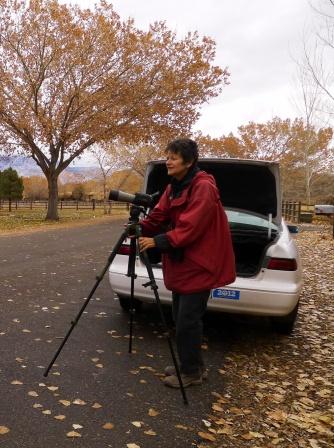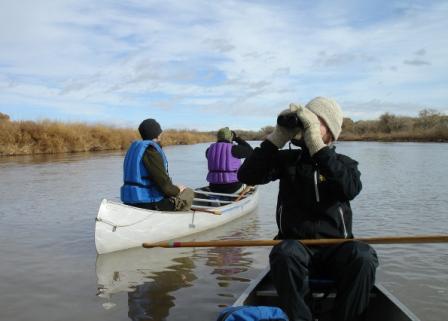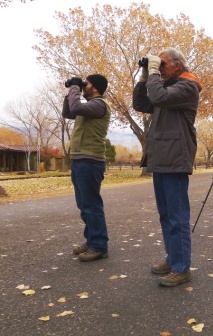
Two Turtle Doves, and
a Partridge in a Pear Tree
Corrales birders mark year’s end with a kinder,
more practical hunt
Among the holiday traditions that are not mourned in modern times is the Christmas Side Hunt, a 19th-century killing spree in which teams of hunters competed to see who could bring in the biggest pile of lifeless fur and feathers.
Hunters (and birds) are no longer so profligate as back then, and what has been handed down to the present era is an alternative tradition begun by the Audubon Society in 1900: the Christmas Bird Census, whereby teams of birdwatchers set out to count birds instead of kill them.
And so it is on a cold and cloudy day in mid-December. About 40 birdwatchers gather before dawn where holiday dinners are now hunted — Sprouts Market — clutching binoculars, clipboards, and coffee. They are among the 2,000 groups, or “circles,” across the continent that take part in this annual birdwatching ritual. Corrales happens to be at the center of one 15-mile-diameter “circle” stretching from the South Valley to Rio Rancho, which means one group is already out on the river in canoes before dawn.

Our hosts this morning are Rebecca Gracey, a veteran birder who has been doing the Corrales count since 1994, her birdwatching partner Joe Schelling, and newcomer Steve Valasek, who got interested in birds when he moved to Rio Rancho from Pittsburgh a year ago. Gracey’s is one of three Corrales teams that set out each year to count every wild bird visible in the Village.
This is not really feasible, of course — birds don’t stay still, after all — and no one pretends to do a complete survey. Instead, this longest-running wildlife census in history serves to provide precious data about the status of wild birds and habitats across the continent, especially over time. It is one of the oldest examples of “citizen science,” putting birdwatchers’ expertise to use in a way that really helps the birds.
“It’s a ritual for birders,” says Gracey. “You know your help is needed.” And while it’s tedious to spend a whole day counting hundreds of pigeons and starlings, certain numbers do inspire debate. For example, Gracey’s team counted one robin in 2001; the next year, they saw 364. The following year, it was five. Gracey speculates that this discrepancy is related to the fruit production on imported Russian olive trees. But so far this year, the team has counted a half dozen robins in the first hour, despite a very dry summer.
“It’s a raptor!” Valasek alerts as the group begins driving residential streets in its territory. Everyone jumps out of the car, clutching binoculars, and Gracey pulls from the trunk a high-powered scope. After some discussion and consulting of field guides, the group decides that the bird — already gone — was a Sharpshinned Hawk, a “sharpie.” Clearly, it helps to have several sets of eyes, ears, and minds to “describe the elephant” once it has left the room.

“Now we’re in the birding mode,” Gracey says with satisfaction, getting back in the car. “We’re hot.”
The car crawls down quiet streets as the passengers call out sightings. Later, when the sun comes out, they will take to the ditch banks and bosque on foot.
“Looks like about a dozen Collared Doves.”
“A house finch — no, two.”
“Rock pigs.” (Rock pigeons — no one’s favorite sighting.)
Gracey makes notes on her clipboard, expertly running her finger down a list compiled from what she’s seen in previous years. “Of course, some are not that exciting,” she concedes. Counting is not what birders do — though she and Schelling spent all of yesterday doing it in San Antonio, near the Bosque del Apache bird refuge. But the trends, over time, are compelling.
Lewis’ Woodpecker, for example, with a beautiful emerald-green back and red breast, used to be seen often in Corrales; now, never. Gracey can only speculate why — possibly loss of habitat, which happens around Albuquerque after surges in housing development. On the flipside, new species appear that were never seen here before, like the Cactus Wren. White-Wing Doves are another southern denizen that has become plentiful in Corrales, based on the dozen or so sighted in the first hour.
The overall number of bird species hasn’t varied much, Gracey says, at around 40 to 45 for her group, and 120 for the Albuquerque region. And while it’s tempting to assume that Corrales must harbor far more avian diversity than downtown Albuquerque, that simply isn’t the case.
One of the group’s favorite sightings is a Western Screech Owl that has been seen in a tree trunk near the Seventh Day Adventist church for the last two years — but he is missing this year. Recently, says Gracey, an expert birder reported an American Woodcock in Corrales, the sort of rare sighting that gives a weary bird counter hope.
Come dusk, the Albuquerque groups meet at O’Niell’s Pub downtown to compare notes and vie for the day’s best spotting. The real satisfaction, though, is in reconnecting with the feathered ’hood. Birds of a feather really do flock together, and for bird-lovers, there’s joy enough in the harmless annual hunt.
Amateur birdwatchers are encouraged to get involved. You can also help gather valuable data for a newer census, the 16th annual Great Backyard Bird Count, held Feb. 15-18 this year.
